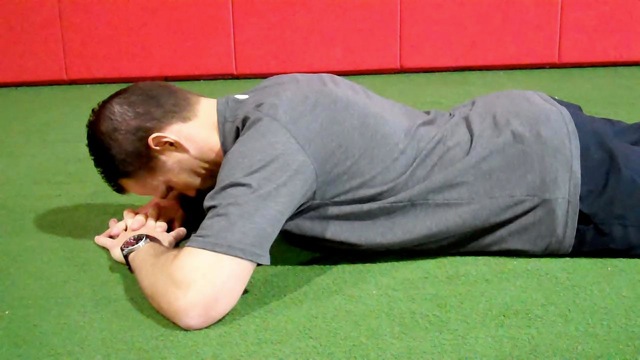
Poor posture and muscle imbalances lead to neck pain and dysfunction. With the increasing reliance on tablets, PC's and cellular phones, most people tend to fall into a forward head posture characterized by lower cervical flexion and upper cervical extension.
Execution:
Execution:
|
|
|
|
Progression:
To add difficulty, increase the hold time or consider adding light manual resistance. Initially, gently add resistance isometrically at end range prior to adding it throughout the range of motion. However, keep in mind the primary goal is activation of the deep flexors and not the extensor muscles, so significant resistance should not be necessary and avoid it altogether if form is compromised in any way.
Regression:
If clients struggle in prone, consider starting in a seated position and cue the movement by placing a finger on the chin and directing the proper pattern and/or allowing them to view the exercise in a mirror. I would suggest supporting the elbows in the seated position to reduce tension from the upper trap/levator and encourage a more upright posture.
The exercise could also be done supine focusing on a chin nod maneuver. My only caution with these two positions is not allowing clients to tilt the chin or look downward instead of retracting the neck.
Application:
Muscles like the sternocleidomastoid tend to become tight and dominate over the deep cervical flexor muscles (longus colli and longus capitis). This leads to diminished neuromuscular activation, postural tension, headaches and problems down the kinetic chain.
You may even see related shoulder dysfunction due to poor cervical posture. Incorporate this exercise to improve cervical posture and muscle activation, which will in turn facilitate optimal thoracic and lumbar alignment and reduce postural tension and neck discomfort.
Brian Schiff, PT, CSCS, is a licensed physical therapist, respected author and fitness professional. Currently, he serves as the supervisor at the Athletic Performance Center in Raleigh, NC. Brian presents nationally at several professional conferences and seminars on injury prevention, rehab and sport-specific training. For more cutting edge training information, subscribe to his monthly Training & Sports Medicine Update at www.BrianSchiff.com.
 Lying face down on the floor, rest the forehead on your hands. This places the neck in some relative lower cervical flexion/upper cervical extension. This is important to allow retraction and activate the deep cervical flexors as you perform the movement.
Lying face down on the floor, rest the forehead on your hands. This places the neck in some relative lower cervical flexion/upper cervical extension. This is important to allow retraction and activate the deep cervical flexors as you perform the movement. Next, slowly retract the neck by pulling the chin back toward the spine. Some may think or refer to this as "packing the neck." Pause for 2-3 seconds and release. Perform 1-3 sets of 5-10 quality repetitions.
Next, slowly retract the neck by pulling the chin back toward the spine. Some may think or refer to this as "packing the neck." Pause for 2-3 seconds and release. Perform 1-3 sets of 5-10 quality repetitions.














